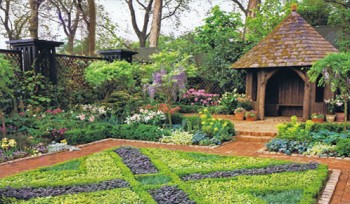 Growing herbs is fun and can contribute to a healthier way of life. Herbs have a myriad of uses from medicinal and culinary to creating sensual pleasure.
Growing herbs is fun and can contribute to a healthier way of life. Herbs have a myriad of uses from medicinal and culinary to creating sensual pleasure.
Whether you have a large garden, live in an inner city terrace or an apartment with only a windowsill or balcony, the adaptability of herbs allows them to be grown in an informal or formal garden, a vegetable garden, in containers or among other plants in the garden.
Most herbs prefer a sunny, well-drained position, with protection from prevailing winds. Shrubby herbs such as rosemary, myrtles, tall lavenders, pelargoniums and bay can be used as windbreaks, rather than high, solid walls. Most herbs prefer an alkaline soil and benefit from digging in well-rotted manure and compost to improve the soil, and assist water retention.
What style of herb garden should I have? Herb garden design is a wonderful combination of traditional garden design and vegetable garden design. It uses both perennial and annual plants decoratively, but with a plant selection determined by their usefulness.
Let’s look at some common herb garden design layouts:
Formal herb garden design
Formal herb gardens are laid out in a series of symmetrical geometric forms with low growing plants forming border hedges and interlinking paths, with topiary features at corners or intersecting points. The geometric layouts use squares, circle or half circles and rely on rhythm as the essential design device. The herbal knot garden design is a classic example. The plants often vary in each garden bed, but the repetitive design and path treatment create unity.
Central garden features such as an urn with cascading herbs, a bubbling water feature or a pond are also incorporated into the design. Herbs can also be grouped and laid out to create interesting colour patterns or scents.
English cottage herb garden design
This more exuberant, less structured design is well suited to those of us who prefer a little organized chaos in our lives!
Often the herbs live happily alongside flowers, vegetables and fruit trees. English cottage herb garden design relies on rhythm created by mass – a volume of the same plants grouped together as borders or drifts. If your garden bed is designed to be viewed from all sides, group the taller plants in the middle and graduate to the shorter plants at the edges.
Meandering paths are also a feature of the English herb garden design. This less structured design lends itself to fragrant ground cover herbs such as thyme and chamomile being inter-planted along garden path paving or flagging to create a wonderful sensual aroma when walked upon.
Container herb garden design
Terraces, balconies, windowsills and steps can all be utilised for container herb planting.
To create a background or soften a wall on a balcony or terrace grow a creeper by fixing wires to the wall and then group your herb containers in varying shapes and sizes at different levels to create visual interest. If space permits consider planting a feature plant such as a Bay tree as a focal point. Don’t use too many small pots. A pleasing arrangement of fewer but larger pots in different heights is more pleasing to the eye.
Consider the heights and spread when grouping your plants. Soften the edges of containers with herbs that hang, droop or creep, such as low-growing varieties of rosemary, creeping golden marjoram, nasturtiums, curly parsley and thyme.
Hanging baskets make maximum use of space and positioned carefully can create scale to your arrangement. Narrow windowsill planters in a sunny position give the added benefit of their fragrance wafting through the window.
I’ve only just touched upon the basics of herb garden design here, but all the fun is in adapting these different styles, adding your own flair and experimenting with what works in your garden, balcony or terrace.
Happy herb gardening!
About Us
Living Colour Landscapes is all about creating inspirational garden designs. Our Sydney-based landscape designers can help you transform any outdoor space, whether you own a garden, a patio, a veranda or a rooftop space.
















